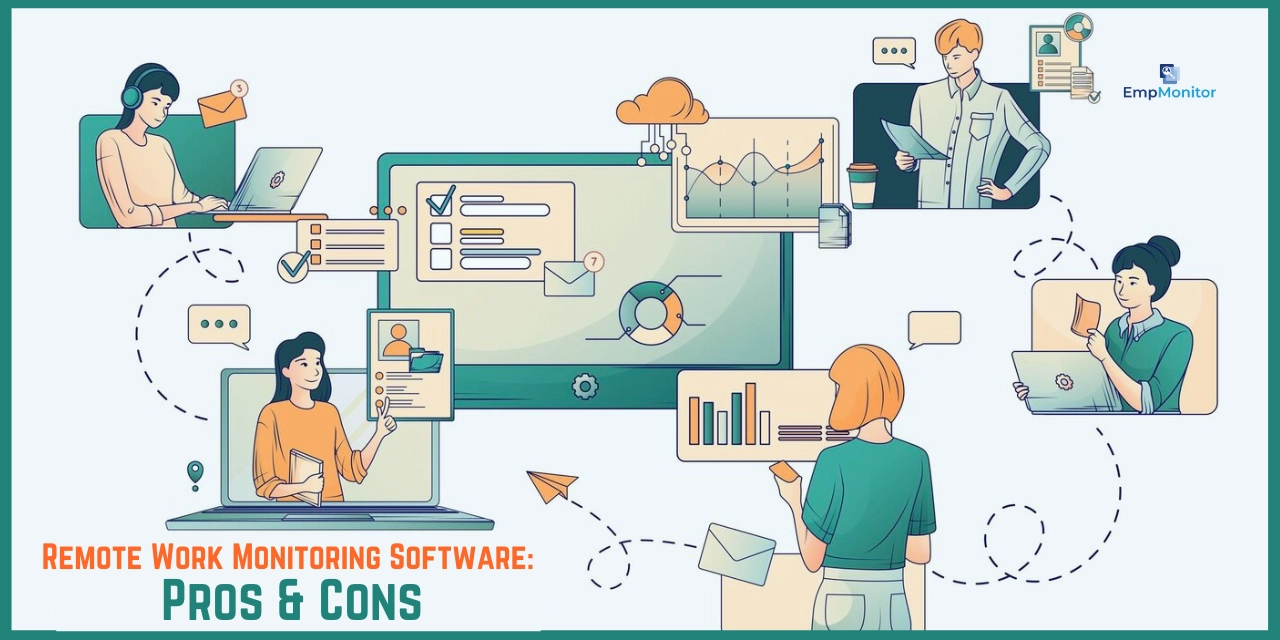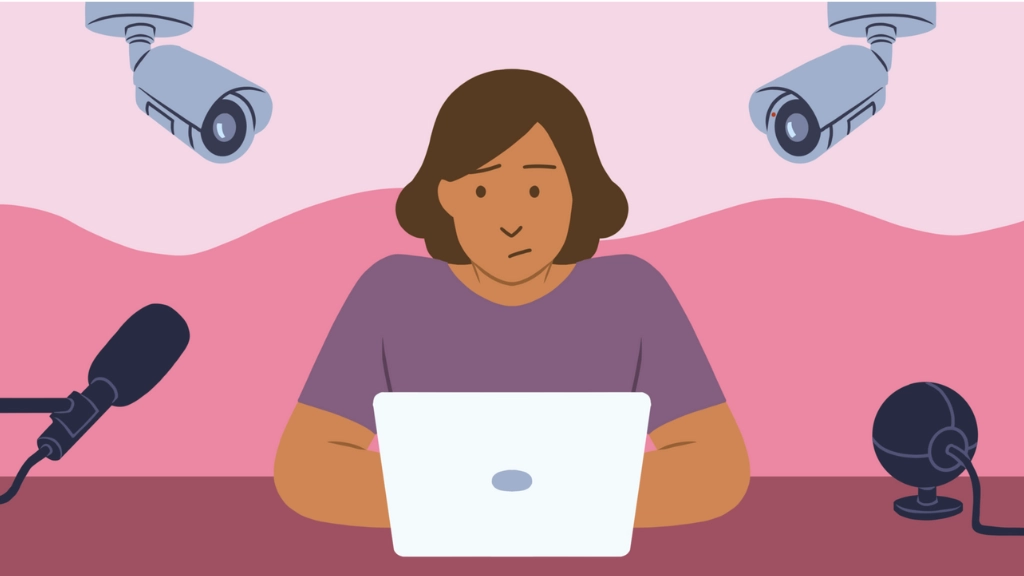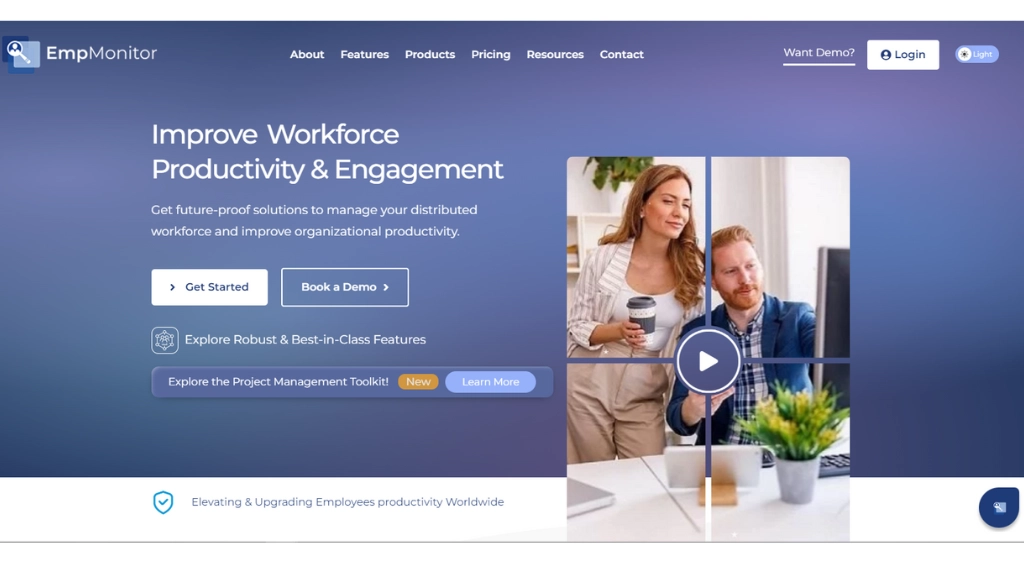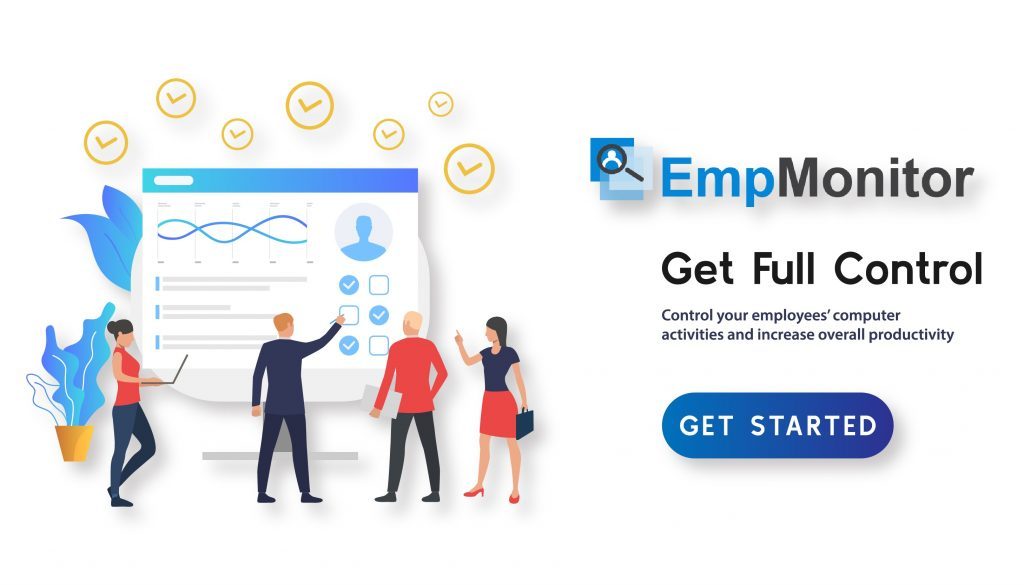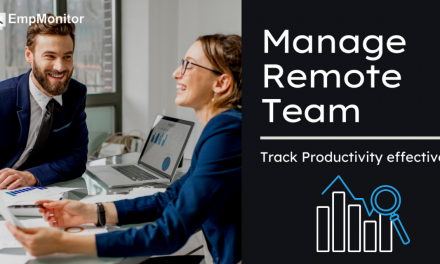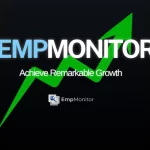As we swoop into more professional dynamics, the compass of work has increasingly pointed toward the virtual horizon. Once unheard of, and now remote work has now become an essential part of the modern workplace.
But the rise brings up a big question – How to effectively monitor and manage distributed teams working remotely? This is where the remote work monitoring software emerges as a potential solution, but its implementation comes with its own set of challenges.
Want To know more? Of course!!
In this blog, we will delve into the heart of the employer’s dilemma, exploring the undeniable pros of monitoring tools while also addressing the legitimate concerns that can keep even the most forward-thinking employers awake at night.
Not only that, we will also tell you some best software monitoring practices so that you will never fall back on productivity. But before, let’s know why software is so popular nowadays and why employees are so concerned about it.
Listen To The Blog Now:
Why Is Remote Work Monitoring Software So Popular?
There are several reasons why remote work tracking software is becoming more popular. With a notable global shift towards remote work, accelerated by technological advancements and the impact of the COVID-19 pandemic, organizations are increasingly recognizing the need for tools that facilitate effective collaboration and ensure productivity in decentralized work environments.
Employers facing the challenge of assuring productivity in remote settings invest in remote user monitoring software to gain insights into work activities and maintain optimal performance levels. Furthermore, security concerns associated with remote access to sensitive data drive the acceptance of monitoring tools to track and secure information, preventing potential data breaches.
Also remember, the adoption of such software is not just a trend but a strategic move, empowering organizations to monitor and elevate productivity, ensuring timely task completion.
However, businesses embracing these monitoring tools for their operational advantages give rise to a parallel narrative—one delving into the concerns of the very individuals whose every keystroke is under observation: the employees. In the delicate dance between productivity and privacy, employee concerns about remote work monitoring software secrets cast a shadow over the digital landscape.
Employees Concerns About Remote Work Monitoring Software:
1. Employees Feel Their Employers Spy on Them
One of the primary concerns that employees harbor regarding remote computer monitoring software is the perceived intrusion into their privacy. Fear of being constantly monitored or controlled can hurt employee morale and overall job satisfaction. To reduce this fear, employers should focus on transparent communication.
Addressing the Concern:
Clear Communication: Establish open communication channels to explain the purpose of the monitoring software. Emphasize that the intent is not to spy but to enhance overall productivity and collaboration.
Policy Development: Clearly define the parameters of monitoring in a comprehensive policy. Outline what aspects will be monitored and reassure employees that their personal space is respected.
2. Employees Feel Their Contributions Won’t Get Recognized
Recognition is a fundamental aspect of employee satisfaction. The implementation of remote work monitoring software has raised concerns among employees that their hard work and contributions might go unnoticed, potentially leading to a decline in motivation and a sense of disconnect from the organization.
Addressing the Concern:
Transparent Metrics: Clearly define the metrics used for performance evaluation. Make sure employees understand how their contributions are measured and recognized through the monitoring software.
Regular Feedback: Create a feedback loop based on the information you’ve gathered all along. Embrace and celebrate personal and team success, creating a healthy work environment.
3. Employees Do Not Know Who Will Access Their Data
Privacy is a significant concern when it comes to remote work monitoring. Employees worry about who has access to the data collected, raising questions about the security of their personal information. This concern can erode trust between employees and employers.
Addressing the Concern:
Data Security Assurance: Communicate the security measures in place to protect employee data. Authorized personnel are responsible for assuring employees that their information is encrypted and exclusively accessible to them.
Transparent Policies: Develop and communicate strict policies regarding data access. Ensure employees understand who can access the data and under what circumstances.
What are the Pros and Cons of Using Remote Work Monitoring Software?
Pros::
1. Increased Productivity
One of the primary advantages of remote work monitoring software is its capacity to boost overall productivity within an organization. By providing real-time insights into employee activities, businesses can identify bottlenecks and inefficiencies, allowing for prompt intervention and optimization of workflows.
How It Works:
Monitoring Tools: These tools track the time employees spend on tasks, identify productive periods, and pinpoint areas for improvement.
Accountability: The awareness of being monitored often encourages employees to stay focused and deliver optimal performance consistently.
Benefits:
Improved Efficiency: Businesses can streamline processes and allocate resources effectively, leading to increased output.
Timely Problem Resolution: With early detection of problems, immediate corrective action can be allowed, reducing the impact on productivity.
2. Time Tracking
Accurate time tracking is a crucial component of effective project management. Remote work monitoring software enables organizations to monitor the time spent on various tasks, providing valuable insights into individual and team efficiency.
How It Works:
Automated Time Tracking: Software automatically records the time spent on different activities, providing a comprehensive overview of work hours.
Project Allocation: Time tracking facilitates the allocation of resources to projects based on real-time data, ensuring optimal utilization.
Benefits:
Resource Optimization: Organizations can allocate resources efficiently, preventing overburdening of individuals or teams.
Project Planning: Accurate time data aids in realistic project planning and helps meet deadlines effectively.
3. Performance Evaluation
Performance evaluation is a critical aspect of employee development. Remote work monitoring software offers an objective and data-driven approach to assessing employee performance, facilitating fair and constructive feedback.
How It Works:
Metrics and KPIs: The software utilizes predefined metrics and key performance indicators (KPIs) to assess individual and team achievements.
Regular Feedback: Managers can provide timely feedback based on measurable data, fostering continuous improvement.
Benefits:
Objective Assessments: Performance evaluations are based on quantifiable data, reducing bias and subjectivity.
Professional Growth: Employees receive constructive feedback that contributes to their professional development and career growth.
4. Security
Data security is a paramount concern for organizations in the digital age. Remote work monitoring software often includes robust security features to protect sensitive information and mitigate the risk of data breaches.
How It Works:
Encryption: Sensitive data is encrypted to prevent unauthorized access and ensure confidentiality.
Access Controls: Access to monitoring data is restricted to authorized personnel, enhancing overall data security.
Benefits:
Data Protection: Organizations can safeguard sensitive information, ensuring compliance with data protection regulations.
Prevention of Breaches: Robust security measures reduce the risk of data breaches, maintaining the integrity of organizational data.
5. Compliance
In industries with stringent regulatory requirements, compliance is non-negotiable. Remote work monitoring software helps organizations adhere to legal and industry-specific guidelines.
How It Works:
Monitoring Policies: Organizations establish monitoring policies aligned with legal requirements and industry standards.
Audit Trails: The software generates audit trails that can show and demonstrate compliance during regulatory audits.
Benefits:
Legal Adherence: Ensures that remote work practices comply with relevant laws and regulations.
Risk Mitigation: Proactive adherence to compliance standards minimizes legal risks and potential penalties.
6. Remote Collaboration
One of the most important benefits of remote computer monitor software is that it allows remote teams to work together. These tools often integrate communication features, file sharing, and project management capabilities to enhance remote collaboration.
How It Works:
Communication Tools: Keep track of Integrated chat, video conferencing, and collaboration platforms to facilitate seamless communication among remote team members.
Project Management: Features like task assignment and progress tracking promote collaborative project execution.
Benefits:
Improved Communication: Enables real-time communication, fostering a sense of connectivity among remote team members.
Enhanced Project Collaboration: Facilitates efficient collaboration on projects, leading to better outcomes and team cohesion.
Employee monitoring software is a key component of modern work environments. It’s an all-in-one solution for businesses who want to manage and enhance their remote workforce.
Monitoring software includes a wide range of tools that track and analyze employee activity to gain valuable insights into employee productivity, time management and work performance.
There are many employee monitoring solutions on the market, but there is one that stands out: EmpMonitor.
EmpMonitor: The Best Employee Monitoring Solution
EmpMonitor is a cloud-based employee monitoring and workforce management system that allows employers to track and manage their employees’ computer activities.
It offers features such as activity monitoring, screenshot capture, keystroke and mouse movement tracking, geo-location tracking, and data loss prevention. The software, designed to enhance productivity, prevent data breaches, and assure a secure work environment, facilitates these outcomes for organizations of all sizes.
While it provides valuable insights for employers, some employees may perceive it as an invasion of privacy, which can lead to conflicts in the organization.
Here are some benefits of EmpMonitor you should know:
Increased Productivity:
EmpMonitor helps improve productivity by allowing employers to monitor employees’ computer activities, and track work hours, and completed tasks, which instills a sense of responsibility in employees, reducing procrastination and unproductive behavior
Enhanced Data Security:
The software provides data loss prevention features, such as website blocking, content filtering, and screenshot capture, to prevent insider threats and ensure data security
Improved Accountability:
With EmpMonitor in place, employers can closely monitor employees’ work hours and completed tasks, leading to increased accountability and a more efficient work environment
Real-time Insights:
EmpMonitor offers real-time insights into employee activities, allowing employers to identify and address any issues that may be affecting productivity
User-Friendly Interface:
The software features a user-friendly and intuitive interface, providing clear reports and information to help manage and monitor employees effectively
These benefits make EmpMonitor a valuable tool for organizations looking to improve productivity, ensure data security, and enhance employee accountability.
Read More:
How To Introduce Remote Worker Monitoring To Employees?
Here Is Why You Need An Advanced Remote Work Monitoring Software
How To Get Ahead In Business With Remote Work Monitoring Software
Cons::
1. Ethical Concerns
The use of remote work monitoring software raises ethical considerations related to employee privacy and autonomy. Employees may perceive constant monitoring as an intrusion into their personal space, leading to a strained employer-employee relationship.
Concerns:
Invasion of Privacy: Continuous monitoring can create a sense of surveillance, eroding trust between employers and employees.
Micromanagement: Excessive monitoring may be perceived as micromanagement, hindering creativity and autonomy in the workplace.
2. Time & Cost
Implementing and maintaining remote worker monitoring software comes with associated time and financial costs. Organizations must carefully weigh these expenses against the anticipated benefits.
Concern:
Resource Strain: Implementing and maintaining remote worker monitoring software can strain organizational resources, affecting other crucial aspects of business operations.
Return on Investment Uncertainty: Organizations face the challenge of ensuring that the time and financial investments in remote work monitoring software yield a significant return, making it imperative to carefully evaluate the anticipated benefits.
3. Legal Implications
Navigating the legal landscape of employee monitoring is complex, and organizations must be aware of and comply with relevant laws to avoid legal repercussions.
Concerns:
Privacy Laws: Failure to adhere to privacy laws may lead to legal challenges and damage the organization’s reputation.
Employee Consent: Obtaining explicit consent from employees for monitoring is essential to comply with legal requirements.
Data Storage and Handling: Properly managing and securing monitoring data is crucial to avoid legal complications.
3 Remote Work Monitoring Software Best practices
1. Transparent Communication
Transparent communication is the cornerstone of successful software monitoring implementation. Clearly articulating the purpose, benefits, and limitations of monitoring helps build trust among employees.
Best Practices:
Open Dialogue: Engage in open conversations with employees about the objectives of software monitoring, emphasizing its role in enhancing collaboration and efficiency.
Policy Communication: Communicate monitoring policies, specifying the aspects under observation and how data will undergo utilization.
2. Customization and Flexibility
Not all roles within an organization require the same level of monitoring. Providing customization options and flexibility in monitoring practices allows employees to feel empowered rather than constrained.
Best Practices:
Role-Based Monitoring: Tailor monitoring practices based on the nature of each role, ensuring relevance and fairness.
User Preferences: Allow employees to customize certain monitoring settings to align with their work preferences.
3. Regular Training and Feedback
Effective use of remote work monitoring software requires a well-informed workforce. Regular training sessions and constructive feedback contribute to a positive user experience.
Best Practices:
Training Programs: Implement comprehensive training programs to educate employees on how to use monitoring tools effectively.
Continuous Feedback: Foster a culture of continuous improvement by providing regular feedback on monitored data, emphasizing positive contributions and addressing areas for enhancement.
In The End!!
All in one, monitoring software has become increasingly popular with the rise of distributed work. While there are pros and cons to monitoring remote workers, improvement-focused monitoring, as opposed to monitoring for the sake of monitoring, can be an all-important enabler in the transition.
Employee monitoring software like EmpMonitor provides crystal-clear access to a huge volume of workday data, which can help tailor monitoring approaches to the areas that matter most to an organization’s success.
The remote work monitoring software best usage includes increased productivity, enhanced data security, improved accountability, real-time insights, and user-friendly interfaces.
When done right and with ethical considerations and an in-depth understanding of the benefits and challenges of employee tracking, this software is the gateway to a workforce that’s not just more productive but more productive and more successful.

